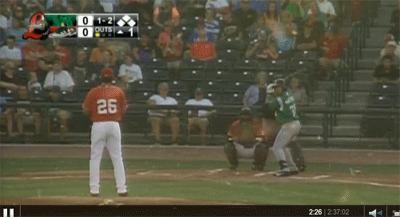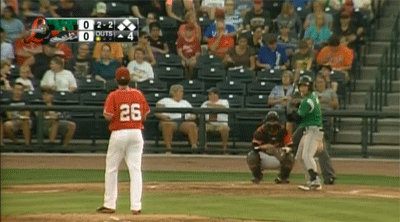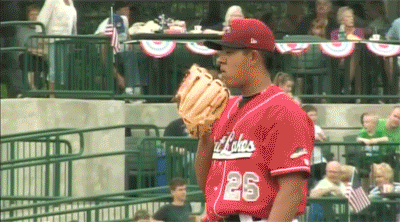The Los Angeles Dodgers have made waves in the international market, with scouting director Logan White procuring a bounty of talent for the organization. Thus far, Yasiel Puig has grabbed the lion's share of the headlines, but the most compelling/intriguing international acquisition by the Dodgers camp may have been Julio Urias, the pitcher whom they plucked out of Mexico in August of 2012, just days after he turned 16 years old.
One would expect the development of a teenager to take a slow pace, with little more than an appearance in short-season rookie ball during his first season. The Dodgers kept Urias in extended spring training into late May, but then they gave him an extremely aggressive assignment to full-season ball, where he joined the Great Lakes Loons as the youngest player in the Midwest League.
|
Level |
K % |
BB % |
H % |
HR % |
|||
|
A |
18 |
54.3 |
2.48 |
31.8% |
7.6% |
20.9% |
2.4% |
The Dodgers were careful with the left-handed prodigy, adhering to strict limits to his innings as well as his pitch counts. He never faced more than 20 batters in a game, and he pitched enough innings to qualify for a victory in only three of his outings (he went 2-0 on the season). Urias' longest start was a dominant six-inning performance on July 3, after which the Dodgers tightened the reins on his workload; he pitched two frames or less in each of his next seven games, despite starting each contest. He was allowed to go a bit deeper near the end of the season, but even his longest start of the second half was capped at four innings, and Urias was shut down for the year on August 29th while his Great Lakes teammates advanced to the playoffs.
Urias' season was a resounding success, from the stingy run prevention to the eye-popping strikeout rate. Every one of his home starts is viewable via MiLB.tv, affording a tremendous opportunity to witness the legend of Uri's gold. I sofa-scouted a number of his outings, going from his professional debut to his final pitch of the year, and the wunderkind left quite an impression.
May 26th vs. Dayton
Urias made his pro debut against a lineup that was stacked with hitters who were anywhere from three to eight years his senior, yet the left-hander was far from overmatched. On the contrary, Urias utilized a low-90s fastball, deep-fading changeup, and slurvy breaking ball to dominate the Dayton Dragons for three innings. He showed off his full arsenal in the first inning en route to a trio of K's, striking out the side in an effort that loudly announced his presence on the prospect map.


Urias located his fastball high and low and inside and outside, and though he had the occasional missed target, he was effective overall in hitting quadrants of the strike zone. He also generated plenty of empty swings within the zone with his fastball, a trait made all the more impressive by the likely growth of his heater as Urias develops.
Urias surrendered his first hit leading off the second inning, putting him into the stretch. Stretch mechanics are less of a concern for southpaws than they are for right-handers, given the differences in strategy with respect to holding runners close, though some lefties will still mess with their deliveries with men on base. Urias retained his normal leg-kick, though he did ramp up the momentum a touch, and it took him a few pitches to find the timing of his stretch delivery. He allowed another single, but by the middle of the inning he had found his release point on the curveball, leading to a vicious K versus Robert Ramirez.

Urias continued to employ more secondaries as the game progressed, showing a willingness to throw any pitch in virtually any count. He spun plenty of first-pitch breaking balls, and was just as likely to reach back for heat with two strikes as he was to become overly reliant on off-speed pitches with movement. The strategy continued to wreak havoc on batter timing, particularly as Urias honed his breaker. The only black mark on an otherwise tremendous outing was a third-inning walk of Zach Vincej, though it took a battle of fouls and just-misses for Vincej to earn the free pass. Urias ended the day with yet another strikeout, getting Joe Terry for the second time of the game, going back to the high heat for the final act of his debut performance.
June 11th vs. West Michigan
Urias had his toughest game of the year on June 11, an outing that included three earned runs in 2.7 innings and a modest pair of strikeouts. All four of the hits surrendered went for extra bases, including the first two homers of his pro career. The main culprit was a lack of pitch command that resulted in a lot of hitter's counts, and his secondary pitches lacked the bite that they’d had in previous outings. Urias fell into the common trap of over-correction, with under-rotated pitches followed immediately by over-rotated deliveries that would miss low and to the glove-side of their targets. He also dealt with a cross-up with his catcher that resulted in the rare two-base penalty on a passed ball.

All of the real damage occurred in the third inning. Urias came out after a 30-minute break due to the seven runs that the Loons offense put up in the bottom of the second, and though the precocious lefty hit 95 mph on the gun with his first pitch of the frame, it was an under-rotated pitch that missed arm-side to right-handed batting Jake Stewart. Urias continued to miss his targets, and Stewart yanked a 2-1 heater that was right in his wheelhouse, blasting the baseball out of the ballpark for the first homer surrendered in Urias’ career as a professional.

Urias discovered his curve for a couple of pitches to Austin Schotts, including some of his best offerings of the day, finishing him with a swooping breaker that had the right-handed Schotts paying for the tab without a swing. The celebration was short-lived, and Urias quickly paid for his transgressions. He surrendered a deep triple to Jared Reaves, followed immediately by an opposite-field liner that cleared the wall by Devon Travis, marking the only game of the 2013 season in which he gave up multiple home runs (in this case, two in one inning). After a lengthy conversation on the mound, Urias gave up another extra-base hit to the next batter, a double to Jeff Holm that effectively knocked the 16-year old from the ballgame.
The June 11th game was the roughest outing of his season, and it kicked off a three-start stretch in which Urias gave up eight earned runs over the course of 11.3 innings. By comparison, he surrendered just seven earnies in his other 15 games combined (he gave up zero unearned runs in 2013). Urias would have his revenge, facing the West Michigan White Caps again three weeks later, a game in which he smote his enemy's ruin upon the mountainside.
July 3rd vs. West Michigan
The White Caps witnessed both the best of times and the worst of times for Julio Urias last season. After having their way with him in mid-June, West Michigan found nothing in their favor once the calendar flipped to July. Urias tossed six innings of scoreless baseball, marking his longest outing of his season, and he set a new career-high with eight strikeouts in the game. The White Caps mustered just a pair of hits and no walks against Urias that day, starting with a 1-2-3 first inning that included a plethora of secondary pitches that produced a couple of strikeouts.

The southpaw punched out four of the first five hitters he faced, using everything in his arsenal to earn early-count strikes as well as finish hitters who had no choice but to slump back to the dugout with confused looks on their faces. His pitch sequencing was superb, as he mixed all of his offerings in virtually any count with a game plan that was completely unpredictable. The calls may have been coming from the dugout or from behind the plate, but Urias had everything working to earn the trust of his catcher and his coaches, and he repeatedly shook off signs in order to dial the right number from his arsenal.

The only damage that could be inflicted came with Connor Harrell at the plate, in the rare instance where Urias was unable to hit his spots. Harrell saw five consecutive pitches on the outer half of the dish, four of which were fastballs, and he took advantage of the last one to the tune of a double to the gap in left-center. But Urias quickly regained his composure, and his sequence to the last batter of the inning was devastating. Facing Jake Stewart, the same batter who had taken Urias out of the yard for the first time, Urias painted a curveball on the outer edge for a called strike, followed by a curve on the hands that was yanked foul, and finished with a fastball at the knees for the backwards K.
 July 10th vs. Burlington
July 10th vs. Burlington
The Burlington game was the start of the stretch in which Urias' innings were handcuffed, and he faced just three batters in the one-inning assignment. However, two things were notable in the lone inning of work: his first-ever hit-by-pitch, and the lefty's pick-off move.

Urias plunked only one batter all season, and this lone HBP was weak on all levels. Leadoff batter Riley Good made little effort to avoid the pitch, and the baseball barely grazed Good's arm. Despite any frustration that may have been felt by Urias, the 16-year old did not show it, and he quickly reaped his vengeance.

After one delivery to the plate, Urias triggered his lift-and-throw pick-off move. Good was either deceived or running on first movement, and he was nailed at second base after the pair of throws. It may have been my favorite moment of the young lefty's season, as there is perhaps nothing more badass than registering a pick-off immediately following an HBP, literally adding insult to injury for the hitter/runner.
The event was par for the course for Urias in 2013, as he picked off a total of five batters in fewer than 55 innings of work. Two of the picks were of this type, where a runner dashed for second and was caught by the relay throw, and three of them were straight pick-offs when the baserunner couldn't get back to the first-base bag. Urias gave up zero stolen bases last season, and the two runners who attempted thefts on deliveries to the plate were caught by the catcher.
Urias actually has a number of moves, ranging from a slow “show me” throw-over to the more aggressive play that caught Good. His third move is also his best, and was busted out in his final start of the season.
August 28th vs. Dayton
Urias' final game of the season was blanketed by gnats, blurring the game feed and potentially adding some distraction from the batters' point of view. Urias was undeterred, however, blanking the Dragons for four innings with five strikeouts and zero walks. The recently-turned 17-year-old was throwing harder than he had all season, peaking at 97 mph in the first inning, and the fastball featured some extra movement in addition to the added juice. Opposing hitters were late on the heater throughout the four innings that Urias was on the mound, and the flailing swing by Jon Matthews was repeated by his teammates throughout the outing.

The curveball and change were also on target in Urias' final outing, leading to some funny swings from batters as they attempted to adjust to the velocity differential mid-hack.

It was a fitting end to a season of tremendous development from an incredibly advanced athlete. Throughout the season, Urias did things on the mound that are unheard-of for a pitcher his age, from his repeatable delivery to his pitch sequencing and even his techniques for keeping baserunners chained to the bag. The first baserunner of the game was leadoff man Beau Amaral, who was privileged to witness the third type of pick-off move from Urias: a quick step off the rubber with the back foot and a snap-throw to the bag that sent Amaral retreating back to the dugout.

Mechanics Report Card
|
Balance |
55 |
|
Momentum |
55 |
|
Torque |
40 |
|
Posture |
55 |
|
Release Distance |
50 |
|
Repetition |
50 |
For an explanation of the grading system for pitching mechanics, please consult this pair of articles.
When digesting the above report card, please consider that this is a high-school-aged kid being graded with a big-league report card. There are very few teenagers who come equipped with mechanical tools that fall within range of major-league average scores, and the 50s on Urias' report card deserve credit for advanced placement.
His momentum is already above-average, particularly with an initial move that leads with the hip and features a powerful thrust toward the plate. Urias slows things down with his second gear, an element that might aid his repetition as he continues to mature physically, but which also raises the ceiling of his OFP from a prospect standpoint, given that he has plenty of room to improve.

Urias has a very quick arm, but his torque is low on efficiency. Most of his current torque comes from hip rotation and proper timing, but all too often his hips and shoulders fire too closely together. He has room to up the ante of upper-body load while also increasing separation with a healthy delay of trunk rotation, and these elements will likely come into play as he grows into his delivery. He also has a tendency to minimize torque on breaking and off-speed pitches, an element with which he can find better consistency in the future while preserving his velocity spreads.

Urias has solid posture overall, though it can be inconsistent, depending on the day and the pitch. He tends to exaggerate spine-tilt on some breaking balls, which is a relatively common trend among developing pitchers, but his fastball posture flashes plus on his good days. He will also right his posture after release point on occasion, straightening up after the ball leaves his hand, but the grade reflects his posture at the moment of release point. His balance is strong, especially for a player who is still in the thick of physical maturation, and he alternates pitches of plus balance with those that have some extra drop-and-drive and a head that can lag behind the center of mass.
The most stunning grade on Urias' report card is the 50-grade repetition. Developing pitchers just do not have the type of consistency of timing and movement that Urias possesses right now, both game to game and within a single outing. He still has room for improvement, to be sure, but even when the southpaw is off-kilter he rarely misses his release point by much. Like any pitcher his age, Urias faces a mountain of work that has to be done before he can reach his potential, but he has an incredible head-start on his baseball journey, and the advanced nature of his skill-set puts him on an accelerated path to the big leagues.
Thank you for reading
This is a free article. If you enjoyed it, consider subscribing to Baseball Prospectus. Subscriptions support ongoing public baseball research and analysis in an increasingly proprietary environment.
Subscribe now